
Best counties to live in Vermont
More counties in the United States experienced population growth in the last year, according to the latest Census data, even as pandemic-related moving trends begin to normalize.
Counties in the South continued to experience growth, particularly in Florida, where 96% of its 67 counties gained new residents. Polk County, Florida, a suburb of Orlando, added the most, with 26,000 people moving there in 2023.
Meanwhile, counties in the Midwest and Northeast continued to lose population, but at slower rates than the year before. Some of the biggest losses were in counties home to large cities, including Cook County, Illinois (home of Chicago) and the boroughs of Brooklyn and Queens in New York.
Many counties are experiencing growth due to their job opportunities, education, or relatively affordable housing costs. Others are favored for their historic or well-designed downtowns or access to cultural opportunities.
Stacker compiled a list of the best counties to live in Vermont using rankings from Niche. Niche ranks counties by various factors including public schools, educational attainment, cost of living, and housing.
Keep reading to see if your county made the list.

#9. Rutland County, Vermont
– Overall Rank: Not ranked
– Population: 60,585
– Median household income: $62,641
– Median home value: $203,500 (72% own)
– Median rent: $891 (28% rent)
– Top public schools: Killington Elementary School (grade A), Barstow Memorial School (grade B+), Middletown Springs Elementary School (grade B+)
– Top private schools: Mount St. Joseph Academy (grade A), Killington Mountain School (grade B+), Rutland Area Christian School (grade B+)
– Top places: Mendon (grade B+), Rutland Town (grade B), Shrewsbury (grade B)

About
Rutland County lies in the heart of Vermont, where the Green Mountains and fertile valleys have long shaped daily life. Its past is tied to marble quarries, farming, and small-town industry, each leaving lasting marks on the landscape and communities. Rutland City serves as the county’s hub, blending historic character with modern services and cultural activity.
Seasonal fairs, mountain trails, and village greens provide settings where neighbors gather and traditions thrive. From farming towns to ski country, the county balances rural heritage with recreational opportunities. Rutland County stands as a place where natural beauty, history, and community identity remain deeply connected.
Where is Rutland County?
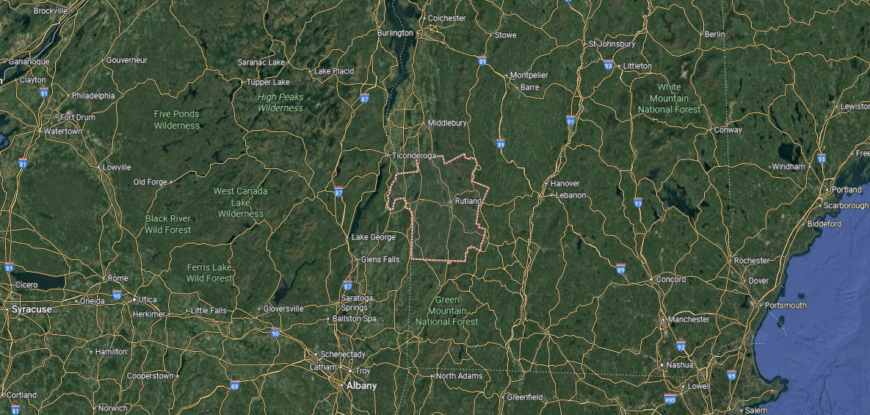
Rutland County is found in west-central Vermont, bordered by Addison County to the north and Windsor County to the southeast. It spans nearly 1,000 square miles, with the Green Mountains running down its eastern side and the Taconic Range forming part of its western border. The county seat, Rutland, lies in the heart of the county along U.S. Route 7.
Other towns include Fair Haven near the New York state line and Brandon to the north along the Otter Creek Valley. Rutland County is about 65 miles south of Burlington and 20 miles east of Lake George, New York. Its setting blends mountain ridges, fertile valleys, and historic villages that highlight Vermont’s rural character.
#8. Orange County, Vermont
– Overall Rank: Not ranked
– Population: 29,439
– Median household income: $74,534
– Median home value: $231,000 (82% own)
– Median rent: $1,125 (18% rent)
– Top public schools: Braintree School (grade A), Newton Elementary School (grade B+), Brookfield School (grade B minus)
– Top private schools: Vermont Academy of Science & Technology (grade B+), Thetford Academy (grade B), Wellspring School (grade unavailable)
– Top places: Williamstown (grade C minus), Thetford (grade B+), Strafford (grade B+)

About
Orange County sits in central Vermont, a region of rolling hills, forested ridges, and towns with deep colonial roots. Its history reflects early farming and craft traditions that gave rise to close-knit communities still defined by self-reliance. Villages across the county maintain classic New England charm, with town greens, historic churches, and strong civic ties.
Life here moves with the seasons—sugaring in spring, fairs in summer, and gatherings that mark the rhythm of rural living. Trails, rivers, and open land offer daily connection to the outdoors. Orange County endures as a landscape where tradition, community, and natural setting weave together in lasting balance.
Where is Orange County?
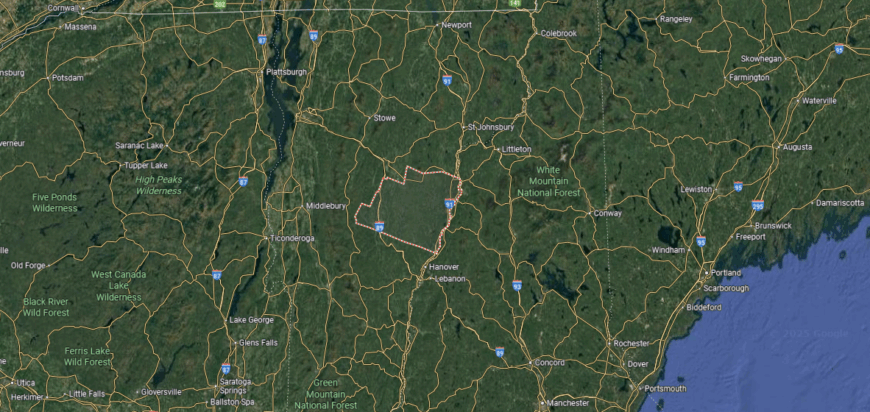
Orange County lies in central Vermont, bordered by Caledonia County to the northeast and Windsor County to the south. It spans just over 690 square miles, with rolling hills, forested uplands, and valleys shaped by the Connecticut River on its eastern edge. The county seat, Chelsea, is located near the geographic center of the county.
Other notable towns include Randolph along Interstate 89 and Bradford on the Connecticut River. Orange County sits about 30 miles south of Montpelier, Vermont’s capital, and 80 miles northwest of Concord, New Hampshire. Its landscape combines farming communities, mountain ridges, and historic town centers that reflect Vermont’s traditional character.
#7. Bennington County, Vermont
– Overall Rank: Not ranked
– Population: 37,326
– Median household income: $68,558
– Median home value: $243,000 (74% own)
– Median rent: $974 (26% rent)
– Top public schools: Readsboro Elementary School (grade B minus), Arlington Memorial Middle/High School (grade B minus), Fisher School (grade C+)
– Top private schools: Long Trail School (grade A), Burr and Burton Academy (grade B+), Grace Christian School (grade B minus)
– Top places: Shaftsbury (grade B), North Bennington (grade B), Bennington (grade C+)

About
Bennington County anchors Vermont’s southwest corner, a place where mountains, valleys, and historic villages define its character. Its story reaches back to Revolutionary War days, with Bennington’s battlefield and monuments still standing as reminders of early American resilience. The county blends this heritage with a landscape of working farms, small towns, and mountain views.
Cultural life thrives through local theaters, art centers, and seasonal festivals that celebrate both tradition and creativity. Outdoor recreation in the Green Mountains and Taconic Range links residents and visitors to the land year-round. Bennington County remains a region where history, culture, and landscape come together in enduring harmony.
Where is Bennington County?
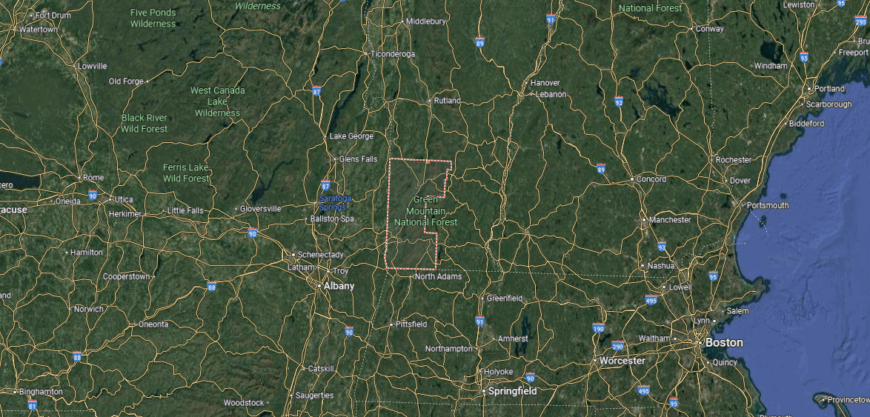
Bennington County sits in the southwestern corner of Vermont, bordered by New York to the west and Massachusetts to the south. Covering about 680 square miles, it is framed by the Taconic Range to the west and the Green Mountains to the east. The county seat, Bennington, lies at the base of Mount Anthony near U.S. Route 7.
Other towns include Manchester to the north, known as a commercial and cultural hub, and Pownal at the southern tip along the Massachusetts border. Bennington County is about 40 miles east of Albany, New York, and 100 miles west of Brattleboro. Its terrain mixes mountain valleys, historic villages, and river corridors that anchor its rural and scenic setting.
#6. Lamoille County, Vermont
– Overall Rank: Not ranked
– Population: 25,977
– Median household income: $69,886
– Median home value: $270,700 (73% own)
– Median rent: $1,066 (27% rent)
– Top public schools: Stowe Elementary School (grade A minus), Morristown Elementary School (grade B), Cambridge Elementary School (grade B)
– Top private schools: Bishop John A. Marshall School (grade unavailable), Wolcott Mennonite School (grade unavailable), Apple Tree Learning Centers (grade unavailable)
– Top places: Elmore (grade A minus), Stowe (grade B+), Morristown (grade B)

About
Lamoille County rests in north-central Vermont, where river valleys and mountain ridges shape both scenery and community life. Its towns reflect a history of farming and small-scale industry, later joined by tourism as nearby peaks drew visitors. The county seat, Hyde Park, anchors local government while surrounding villages maintain their rural traditions.
Stowe and other resort areas highlight the county’s reputation for skiing, trails, and outdoor adventure. Farmers’ markets, school events, and seasonal fairs keep civic life rooted in shared connections. Lamoille County stands as a place where mountain landscapes and community heritage blend into a vibrant, year-round rhythm.
Where is Lamoille County?

Lamoille County is located in north-central Vermont, bordered by Franklin County to the northwest and Caledonia County to the east. It covers roughly 460 square miles, making it one of the state’s smaller counties in area. The county seat, Hyde Park, is set along the Lamoille River near the center of the county.
Other towns include Morrisville, a key commercial center, and Stowe, a well-known resort community at the base of Mount Mansfield. Lamoille County is about 35 miles northeast of Burlington and 25 miles northwest of Montpelier. Its landscape features river valleys, forested hills, and ski country that contribute to both its economy and identity.
#5. Windham County, Vermont
– Overall Rank: Not ranked
– Population: 45,857
– Median household income: $65,473
– Median home value: $250,000 (72% own)
– Median rent: $1,031 (28% rent)
– Top public schools: Wardsboro Central School (grade A), Dover Elementary School (grade A), Halifax West School (grade A minus)
– Top private schools: The Putney School (grade A+), Vermont Academy (grade A+), Stratton Mountain School (grade A)
– Top places: Dummerston (grade B+), Guilford (grade B), Rockingham (grade B minus)

About
Windham County occupies Vermont’s southeastern corner, where the Connecticut River and the Green Mountains frame a landscape of valleys and ridges. Its towns carry a legacy of early mills, farming, and trade routes that shaped both settlement and identity. Brattleboro, the county’s cultural hub, blends historic charm with a reputation for arts, music, and local enterprise.
The county’s rhythm is marked by farmers’ markets, seasonal festivals, and outdoor life along rivers and forest trails. Smaller villages preserve strong community ties while adding their own traditions to the region’s character. Windham County remains a place where culture, history, and natural setting come together in enduring balance.
Where is Windham County?
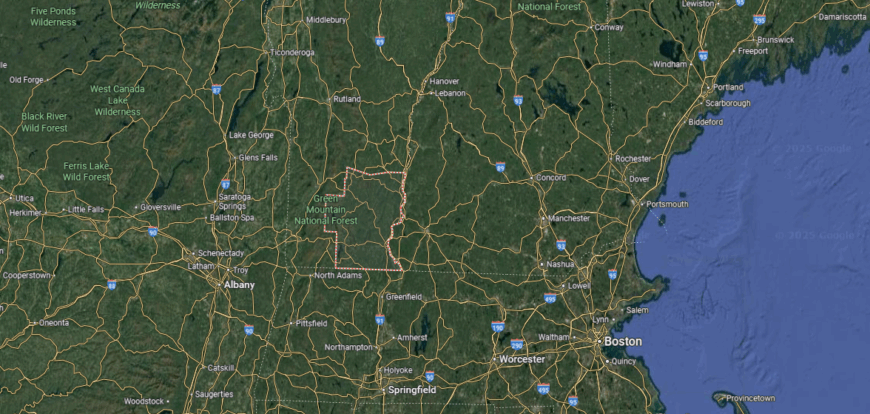
Windham County sits in the southeastern corner of Vermont, bordered by New Hampshire to the east along the Connecticut River and Massachusetts to the south. It spans about 800 square miles, with the Green Mountains rising through its western half and valleys spreading toward the river plain. The county seat, Newfane, is located north of Brattleboro along the West River.
Other communities include Brattleboro, the county’s largest town near the Massachusetts line, and Bellows Falls along the Connecticut River. Windham County lies about 100 miles northwest of Boston and 120 miles northeast of Albany, New York. Its geography blends mountain ridges, fertile valleys, and historic villages that reflect Vermont’s rural traditions.
#4. Windsor County, Vermont
– Overall Rank: 1,082
– Population: 57,832
– Median household income: $69,492
– Median home value: $249,700 (77% own)
– Median rent: $1,054 (23% rent)
– Top public schools: Barnard Academy (grade A+), Marion W. Cross School (grade A), Woodstock Elementary School (grade A)
– Top private schools: Mid Vermont Christian School (grade A minus), The Sharon Academy (grade B), Upper Valley Waldorf School (grade unavailable)
– Top places: Norwich (grade A+), Wilder (grade A minus), Weathersfield (grade B)

About
Windsor County stretches across central Vermont, where covered bridges, historic villages, and rolling farmland define its identity. Known as the birthplace of Vermont’s statehood, the county carries a strong sense of history rooted in its early settlements and traditions. Woodstock serves as a focal point, blending cultural life with classic New England character.
Recreation along rivers, in forests, and on mountain slopes ties residents to the landscape throughout the year. Local fairs, craft traditions, and civic gatherings sustain community connections across generations. Windsor County endures as a place where heritage and natural beauty shape both daily life and regional pride.
Where is Windsor County?
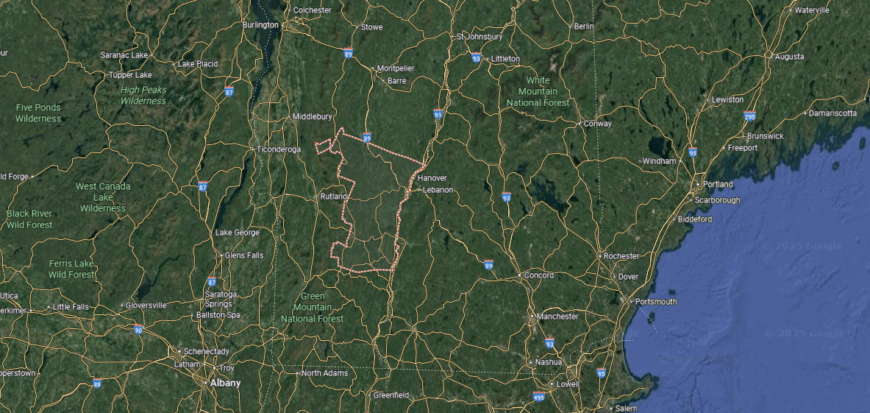
Windsor County is in southeastern Vermont, bordered by Orange County to the north and Windham County to the south. It covers nearly 1,000 square miles, stretching from the peaks of the Green Mountains in the west to the Connecticut River valley in the east. The county seat, Woodstock, lies in the central part of the county and is known for its historic village setting.
Other towns include Springfield along the Connecticut River and Hartford at the junction of Interstates 89 and 91. Windsor County is about 60 miles south of Montpelier and 120 miles northwest of Boston. Its landscape features mountain ridges, river valleys, and farmland that connect both natural beauty and traditional Vermont life.
#3. Addison County, Vermont
– Overall Rank: 616
– Population: 37,434
– Median household income: $85,870
– Median home value: $311,200 (79% own)
– Median rent: $1,153 (21% rent)
– Top public schools: Weybridge Elementary School (grade A+), Bingham Memorial School (grade A), Ferrisburgh Central School (grade A)
– Top private schools: The Red Cedar School (grade unavailable), Bridge School (grade unavailable), Champlain Valley Christian School (grade unavailable)
– Top places: Middlebury (grade A), Cornwall (grade A minus), Ferrisburgh (grade A minus)

About
Addison County lies along the shores of Lake Champlain, its open valleys framed by the Adirondacks to the west and the Green Mountains to the east. The county’s story is built on farming, lake trade, and early industries that gave its towns a lasting sense of purpose. Middlebury, home to the college, anchors the region with education, culture, and historic character.
Vineyards, farms, and village greens shape the rhythm of community life, while the lake and mountains provide recreation year-round. Residents gather through festivals, markets, and traditions that highlight both heritage and place. Addison County stands as a region where agricultural roots, learning, and natural beauty come together seamlessly.
Where is Addison County?

Addison County is located in western Vermont, bordered by Chittenden County to the north and Rutland County to the south. It spans nearly 800 square miles, with Lake Champlain forming its western boundary and the Green Mountains rising to the east. The county seat, Middlebury, sits in the center of the county along Otter Creek.
Other communities include Vergennes, Vermont’s smallest city, near Lake Champlain and Bristol at the foothills of the Green Mountains. Addison County lies about 35 miles south of Burlington and 70 miles east of Albany, New York. Its geography blends fertile valleys, lakefront plains, and mountain slopes, giving it both agricultural and scenic importance.
#2. Washington County, Vermont
– Overall Rank: 470
– Population: 59,768
– Median household income: $77,278
– Median home value: $278,000 (73% own)
– Median rent: $1,077 (27% rent)
– Top public schools: Waitsfield Elementary School (grade A+), Warren Elementary School (grade A), Fayston Elementary School (grade A)
– Top private schools: Green Mountain Valley School (grade A+), Websterville Christian Academy (grade B+), Orchard Valley Waldorf School (grade unavailable)
– Top places: Montpelier (grade A), Moretown (grade A minus), East Montpelier (grade A minus)

About
Washington County rests at Vermont’s center, where hills, rivers, and historic towns give it both scenic and civic importance. Its history is tied to early mills, granite quarries, and state government, with Montpelier serving as the smallest U.S. capital yet full of historic presence. Barre adds another layer of identity with its granite heritage and strong working-class traditions.
Seasonal fairs, arts festivals, and outdoor activities on trails and waterways keep community life active and connected. From mountain villages to bustling civic hubs, the county reflects a balance of tradition and modern growth. Washington County remains a place where history, government, and community spirit are deeply intertwined.
Where is Washington County?
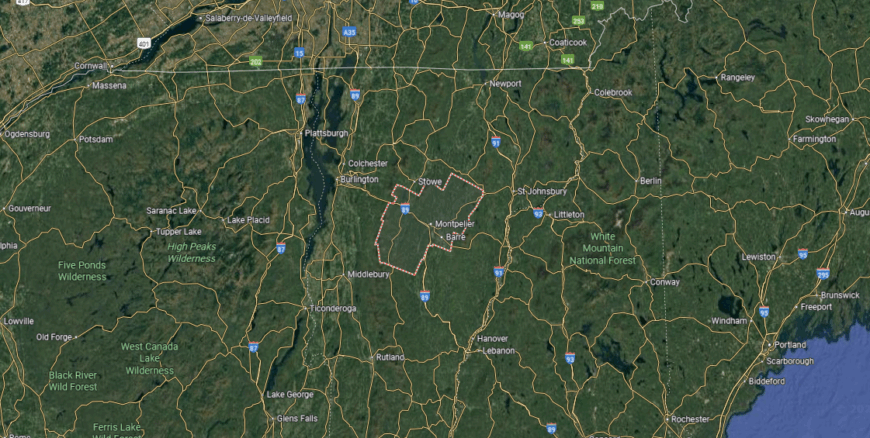
Washington County lies in central Vermont, bordered by Lamoille County to the north and Orange County to the east. It covers about 690 square miles, with the Green Mountains cutting through its western side and valleys opening toward the Winooski River basin. The county seat, Montpelier, also serves as Vermont’s capital and is located along the North Branch of the Winooski River.
Other towns include Barre, known for its granite industry, and Waterbury, positioned along Interstate 89 near the Green Mountains. Washington County is roughly 40 miles southeast of Burlington and 125 miles northwest of Concord, New Hampshire. Its terrain combines mountain ridges, river valleys, and historic town centers that reflect both industry and governance.
#1. Chittenden County, Vermont
– Overall Rank: 178
– Population: 168,309
– Median household income: $89,494
– Median home value: $378,300 (63% own)
– Median rent: $1,511 (37% rent)
– Top public schools: Camels Hump Middle School (grade A), Charlotte Central School (grade A), South Burlington High School (grade A)
– Top private schools: Lake Champlain Waldorf School (grade A), Vermont Commons School (grade A), Rice Memorial High School (grade A minus)
– Top places: South Burlington (grade A+), Five Sisters (grade A), Shelburne (grade A)

About
Chittenden County sits along the shores of Lake Champlain, its setting marked by water, mountains, and Vermont’s most dynamic communities. Burlington, the county seat, blends a tradition of industry and trade with a strong presence of education, arts, and civic life. Surrounding towns contribute farmland, forested landscapes, and a steady rhythm of rural heritage.
Lakefront festivals, farmers’ markets, and cultural events create a lively community atmosphere tied to both land and water. Trails, ski areas, and open spaces connect residents to outdoor life throughout the seasons. Chittenden County stands as Vermont’s most populous region, where natural setting and cultural vitality meet.
Where is Chittenden County?
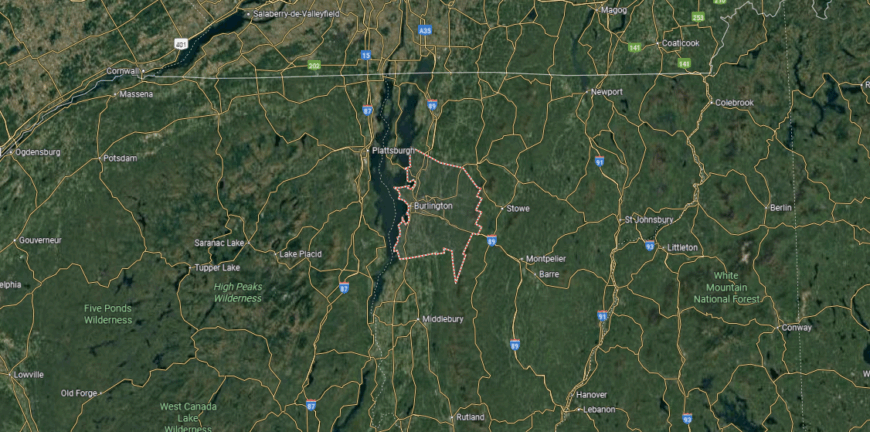
Chittenden County is located in northwestern Vermont, bordered by Addison County to the south and Franklin County to the north. Covering about 620 square miles, it stretches from the shores of Lake Champlain on the west to the western slopes of the Green Mountains on the east. The county seat, Burlington, is also Vermont’s largest city and sits along the lakefront.
Other communities include South Burlington, Essex, and Colchester, which form part of the county’s growing metropolitan area. Chittenden County lies about 95 miles south of Montreal and 215 miles northwest of Boston, giving it strong regional connections. Its geography combines lake plains, mountain foothills, and urban development, making it the state’s economic and population center.
This story features data reporting and writing by Elena Cox and is part of a series utilizing data automation across 50 states.
By Stacker






